Financial Accounting Report: Australian Business Liquidations
VerifiedAdded on 2023/04/22
|8
|2934
|150
Report
AI Summary
This report provides a comprehensive analysis of the liquidations of three prominent Australian companies: HIH Insurance, Aluminum Boats Australia, and Stellar Homes. It begins with an executive summary and table of contents, followed by a descriptive discussion of each company's business operations and the events that led to their financial collapse. The report then delves into the causes of liquidation, highlighting factors such as a fire at Aluminum Boats Australia, mismanagement and risky investments at HIH Insurance, and stiff competition and cash flow issues at Stellar Homes. Furthermore, it examines the APES 110 Code of Ethics for Professional Accountants, outlining the key ethical principles and their relevance to the cases. The report also assesses corporate governance issues that contributed to each company's downfall and discusses the types of liquidation each underwent. Finally, it evaluates the role of liabilities in the companies' failures, concluding with a summary of the key findings and a list of references.
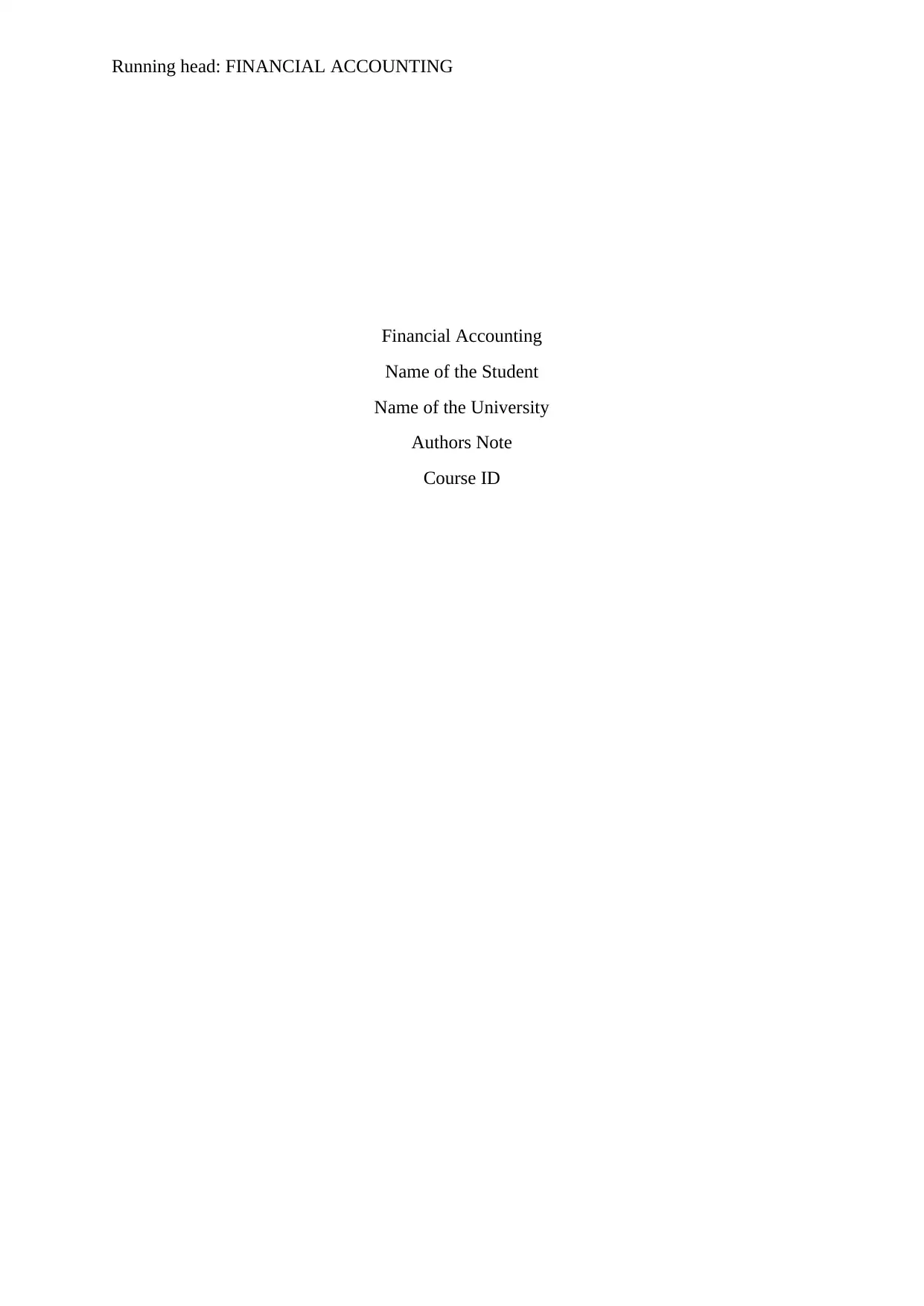
Running head: FINANCIAL ACCOUNTING
Financial Accounting
Name of the Student
Name of the University
Authors Note
Course ID
Financial Accounting
Name of the Student
Name of the University
Authors Note
Course ID
Paraphrase This Document
Need a fresh take? Get an instant paraphrase of this document with our AI Paraphraser
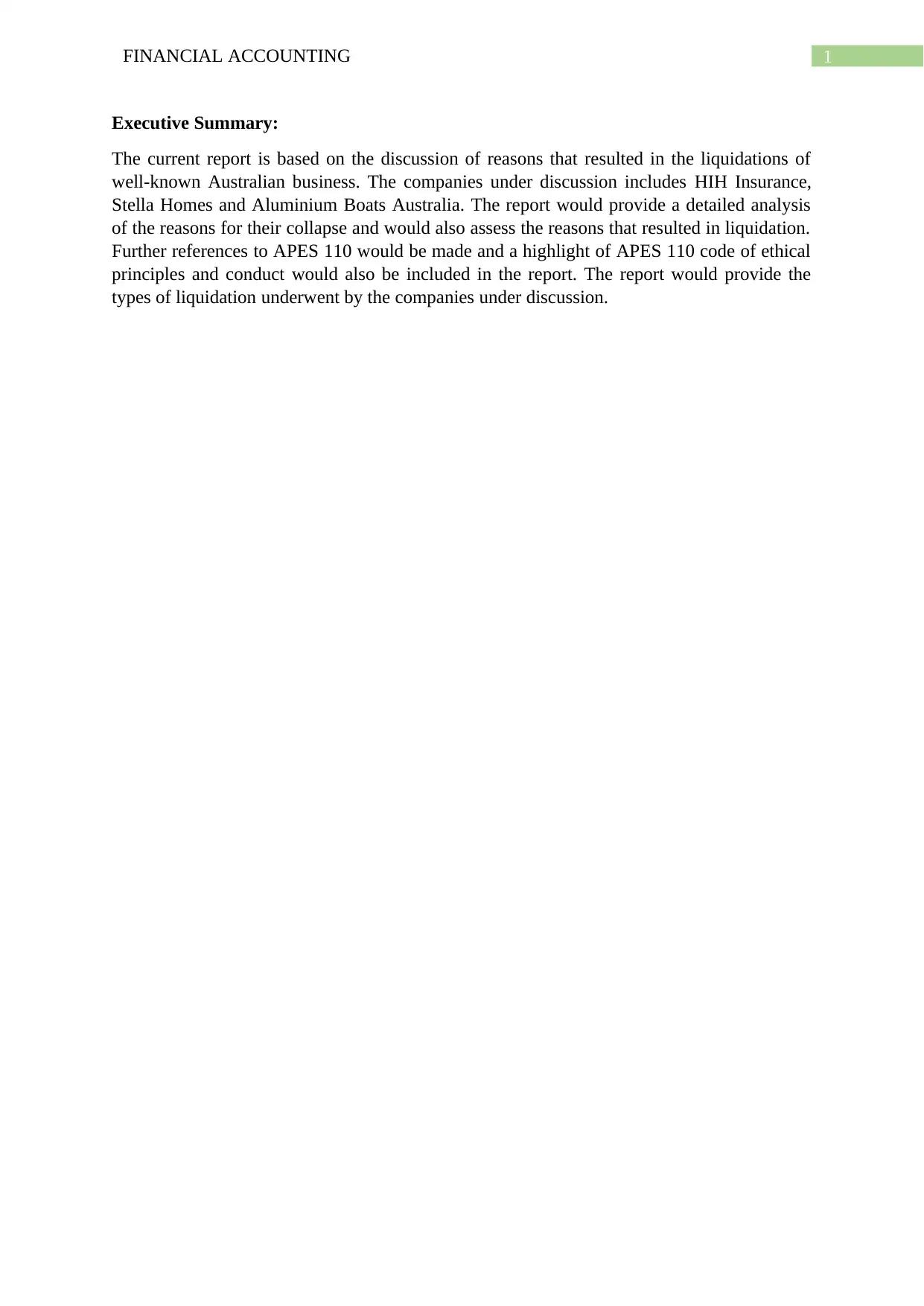
1FINANCIAL ACCOUNTING
Executive Summary:
The current report is based on the discussion of reasons that resulted in the liquidations of
well-known Australian business. The companies under discussion includes HIH Insurance,
Stella Homes and Aluminium Boats Australia. The report would provide a detailed analysis
of the reasons for their collapse and would also assess the reasons that resulted in liquidation.
Further references to APES 110 would be made and a highlight of APES 110 code of ethical
principles and conduct would also be included in the report. The report would provide the
types of liquidation underwent by the companies under discussion.
Executive Summary:
The current report is based on the discussion of reasons that resulted in the liquidations of
well-known Australian business. The companies under discussion includes HIH Insurance,
Stella Homes and Aluminium Boats Australia. The report would provide a detailed analysis
of the reasons for their collapse and would also assess the reasons that resulted in liquidation.
Further references to APES 110 would be made and a highlight of APES 110 code of ethical
principles and conduct would also be included in the report. The report would provide the
types of liquidation underwent by the companies under discussion.
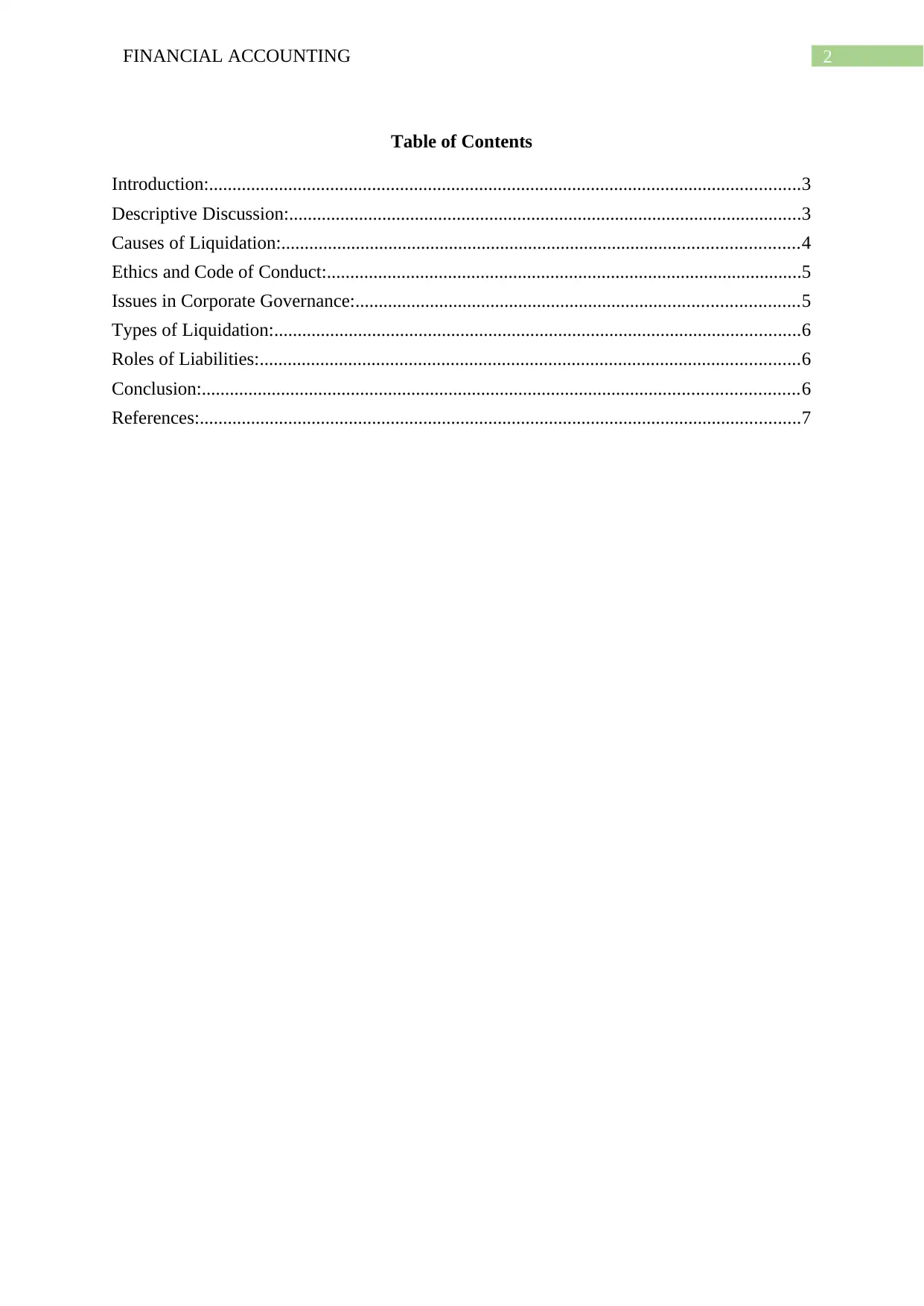
2FINANCIAL ACCOUNTING
Table of Contents
Introduction:...............................................................................................................................3
Descriptive Discussion:..............................................................................................................3
Causes of Liquidation:...............................................................................................................4
Ethics and Code of Conduct:......................................................................................................5
Issues in Corporate Governance:...............................................................................................5
Types of Liquidation:.................................................................................................................6
Roles of Liabilities:....................................................................................................................6
Conclusion:................................................................................................................................6
References:.................................................................................................................................7
Table of Contents
Introduction:...............................................................................................................................3
Descriptive Discussion:..............................................................................................................3
Causes of Liquidation:...............................................................................................................4
Ethics and Code of Conduct:......................................................................................................5
Issues in Corporate Governance:...............................................................................................5
Types of Liquidation:.................................................................................................................6
Roles of Liabilities:....................................................................................................................6
Conclusion:................................................................................................................................6
References:.................................................................................................................................7
⊘ This is a preview!⊘
Do you want full access?
Subscribe today to unlock all pages.

Trusted by 1+ million students worldwide
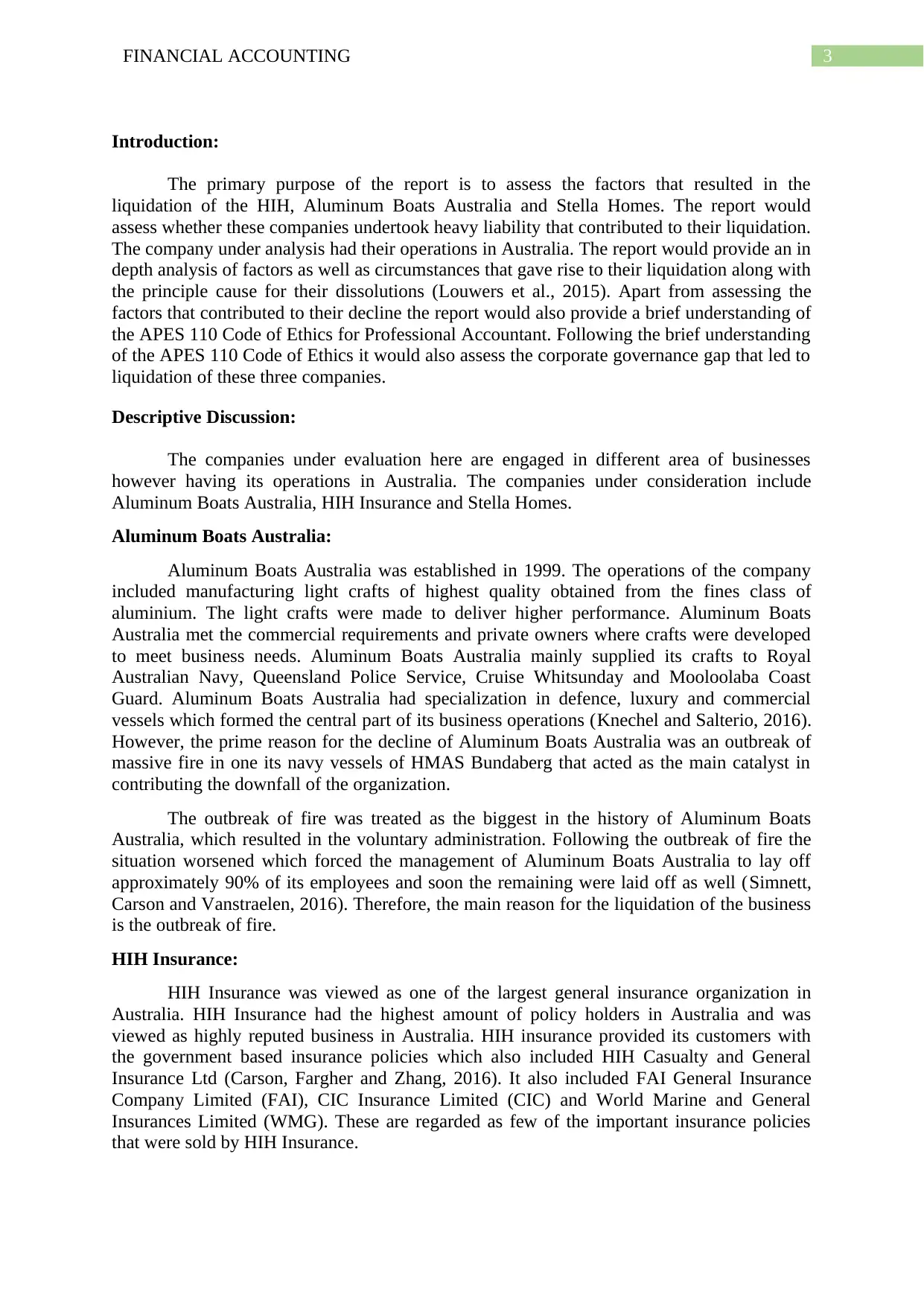
3FINANCIAL ACCOUNTING
Introduction:
The primary purpose of the report is to assess the factors that resulted in the
liquidation of the HIH, Aluminum Boats Australia and Stella Homes. The report would
assess whether these companies undertook heavy liability that contributed to their liquidation.
The company under analysis had their operations in Australia. The report would provide an in
depth analysis of factors as well as circumstances that gave rise to their liquidation along with
the principle cause for their dissolutions (Louwers et al., 2015). Apart from assessing the
factors that contributed to their decline the report would also provide a brief understanding of
the APES 110 Code of Ethics for Professional Accountant. Following the brief understanding
of the APES 110 Code of Ethics it would also assess the corporate governance gap that led to
liquidation of these three companies.
Descriptive Discussion:
The companies under evaluation here are engaged in different area of businesses
however having its operations in Australia. The companies under consideration include
Aluminum Boats Australia, HIH Insurance and Stella Homes.
Aluminum Boats Australia:
Aluminum Boats Australia was established in 1999. The operations of the company
included manufacturing light crafts of highest quality obtained from the fines class of
aluminium. The light crafts were made to deliver higher performance. Aluminum Boats
Australia met the commercial requirements and private owners where crafts were developed
to meet business needs. Aluminum Boats Australia mainly supplied its crafts to Royal
Australian Navy, Queensland Police Service, Cruise Whitsunday and Mooloolaba Coast
Guard. Aluminum Boats Australia had specialization in defence, luxury and commercial
vessels which formed the central part of its business operations (Knechel and Salterio, 2016).
However, the prime reason for the decline of Aluminum Boats Australia was an outbreak of
massive fire in one its navy vessels of HMAS Bundaberg that acted as the main catalyst in
contributing the downfall of the organization.
The outbreak of fire was treated as the biggest in the history of Aluminum Boats
Australia, which resulted in the voluntary administration. Following the outbreak of fire the
situation worsened which forced the management of Aluminum Boats Australia to lay off
approximately 90% of its employees and soon the remaining were laid off as well (Simnett,
Carson and Vanstraelen, 2016). Therefore, the main reason for the liquidation of the business
is the outbreak of fire.
HIH Insurance:
HIH Insurance was viewed as one of the largest general insurance organization in
Australia. HIH Insurance had the highest amount of policy holders in Australia and was
viewed as highly reputed business in Australia. HIH insurance provided its customers with
the government based insurance policies which also included HIH Casualty and General
Insurance Ltd (Carson, Fargher and Zhang, 2016). It also included FAI General Insurance
Company Limited (FAI), CIC Insurance Limited (CIC) and World Marine and General
Insurances Limited (WMG). These are regarded as few of the important insurance policies
that were sold by HIH Insurance.
Introduction:
The primary purpose of the report is to assess the factors that resulted in the
liquidation of the HIH, Aluminum Boats Australia and Stella Homes. The report would
assess whether these companies undertook heavy liability that contributed to their liquidation.
The company under analysis had their operations in Australia. The report would provide an in
depth analysis of factors as well as circumstances that gave rise to their liquidation along with
the principle cause for their dissolutions (Louwers et al., 2015). Apart from assessing the
factors that contributed to their decline the report would also provide a brief understanding of
the APES 110 Code of Ethics for Professional Accountant. Following the brief understanding
of the APES 110 Code of Ethics it would also assess the corporate governance gap that led to
liquidation of these three companies.
Descriptive Discussion:
The companies under evaluation here are engaged in different area of businesses
however having its operations in Australia. The companies under consideration include
Aluminum Boats Australia, HIH Insurance and Stella Homes.
Aluminum Boats Australia:
Aluminum Boats Australia was established in 1999. The operations of the company
included manufacturing light crafts of highest quality obtained from the fines class of
aluminium. The light crafts were made to deliver higher performance. Aluminum Boats
Australia met the commercial requirements and private owners where crafts were developed
to meet business needs. Aluminum Boats Australia mainly supplied its crafts to Royal
Australian Navy, Queensland Police Service, Cruise Whitsunday and Mooloolaba Coast
Guard. Aluminum Boats Australia had specialization in defence, luxury and commercial
vessels which formed the central part of its business operations (Knechel and Salterio, 2016).
However, the prime reason for the decline of Aluminum Boats Australia was an outbreak of
massive fire in one its navy vessels of HMAS Bundaberg that acted as the main catalyst in
contributing the downfall of the organization.
The outbreak of fire was treated as the biggest in the history of Aluminum Boats
Australia, which resulted in the voluntary administration. Following the outbreak of fire the
situation worsened which forced the management of Aluminum Boats Australia to lay off
approximately 90% of its employees and soon the remaining were laid off as well (Simnett,
Carson and Vanstraelen, 2016). Therefore, the main reason for the liquidation of the business
is the outbreak of fire.
HIH Insurance:
HIH Insurance was viewed as one of the largest general insurance organization in
Australia. HIH Insurance had the highest amount of policy holders in Australia and was
viewed as highly reputed business in Australia. HIH insurance provided its customers with
the government based insurance policies which also included HIH Casualty and General
Insurance Ltd (Carson, Fargher and Zhang, 2016). It also included FAI General Insurance
Company Limited (FAI), CIC Insurance Limited (CIC) and World Marine and General
Insurances Limited (WMG). These are regarded as few of the important insurance policies
that were sold by HIH Insurance.
Paraphrase This Document
Need a fresh take? Get an instant paraphrase of this document with our AI Paraphraser
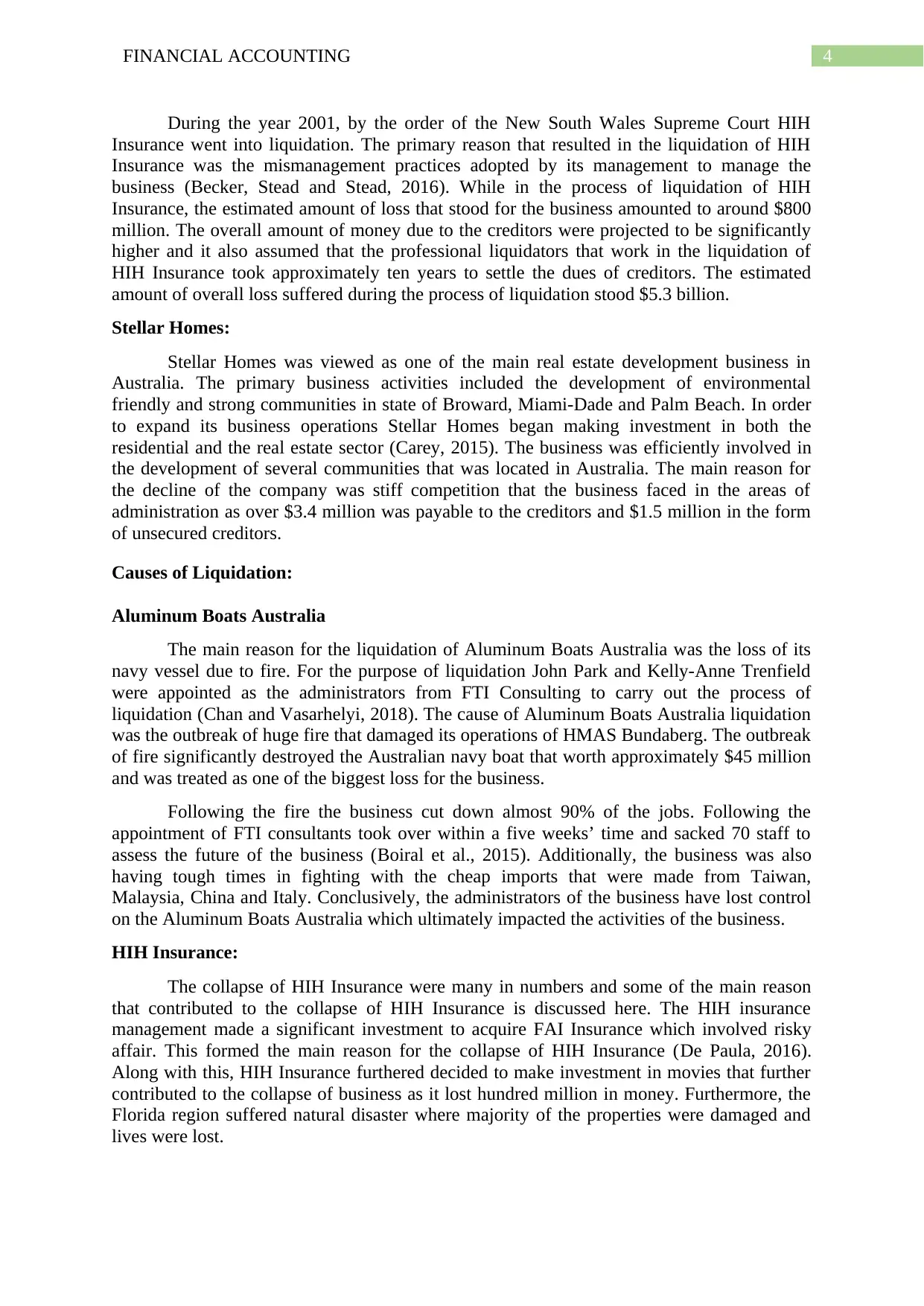
4FINANCIAL ACCOUNTING
During the year 2001, by the order of the New South Wales Supreme Court HIH
Insurance went into liquidation. The primary reason that resulted in the liquidation of HIH
Insurance was the mismanagement practices adopted by its management to manage the
business (Becker, Stead and Stead, 2016). While in the process of liquidation of HIH
Insurance, the estimated amount of loss that stood for the business amounted to around $800
million. The overall amount of money due to the creditors were projected to be significantly
higher and it also assumed that the professional liquidators that work in the liquidation of
HIH Insurance took approximately ten years to settle the dues of creditors. The estimated
amount of overall loss suffered during the process of liquidation stood $5.3 billion.
Stellar Homes:
Stellar Homes was viewed as one of the main real estate development business in
Australia. The primary business activities included the development of environmental
friendly and strong communities in state of Broward, Miami-Dade and Palm Beach. In order
to expand its business operations Stellar Homes began making investment in both the
residential and the real estate sector (Carey, 2015). The business was efficiently involved in
the development of several communities that was located in Australia. The main reason for
the decline of the company was stiff competition that the business faced in the areas of
administration as over $3.4 million was payable to the creditors and $1.5 million in the form
of unsecured creditors.
Causes of Liquidation:
Aluminum Boats Australia
The main reason for the liquidation of Aluminum Boats Australia was the loss of its
navy vessel due to fire. For the purpose of liquidation John Park and Kelly-Anne Trenfield
were appointed as the administrators from FTI Consulting to carry out the process of
liquidation (Chan and Vasarhelyi, 2018). The cause of Aluminum Boats Australia liquidation
was the outbreak of huge fire that damaged its operations of HMAS Bundaberg. The outbreak
of fire significantly destroyed the Australian navy boat that worth approximately $45 million
and was treated as one of the biggest loss for the business.
Following the fire the business cut down almost 90% of the jobs. Following the
appointment of FTI consultants took over within a five weeks’ time and sacked 70 staff to
assess the future of the business (Boiral et al., 2015). Additionally, the business was also
having tough times in fighting with the cheap imports that were made from Taiwan,
Malaysia, China and Italy. Conclusively, the administrators of the business have lost control
on the Aluminum Boats Australia which ultimately impacted the activities of the business.
HIH Insurance:
The collapse of HIH Insurance were many in numbers and some of the main reason
that contributed to the collapse of HIH Insurance is discussed here. The HIH insurance
management made a significant investment to acquire FAI Insurance which involved risky
affair. This formed the main reason for the collapse of HIH Insurance (De Paula, 2016).
Along with this, HIH Insurance furthered decided to make investment in movies that further
contributed to the collapse of business as it lost hundred million in money. Furthermore, the
Florida region suffered natural disaster where majority of the properties were damaged and
lives were lost.
During the year 2001, by the order of the New South Wales Supreme Court HIH
Insurance went into liquidation. The primary reason that resulted in the liquidation of HIH
Insurance was the mismanagement practices adopted by its management to manage the
business (Becker, Stead and Stead, 2016). While in the process of liquidation of HIH
Insurance, the estimated amount of loss that stood for the business amounted to around $800
million. The overall amount of money due to the creditors were projected to be significantly
higher and it also assumed that the professional liquidators that work in the liquidation of
HIH Insurance took approximately ten years to settle the dues of creditors. The estimated
amount of overall loss suffered during the process of liquidation stood $5.3 billion.
Stellar Homes:
Stellar Homes was viewed as one of the main real estate development business in
Australia. The primary business activities included the development of environmental
friendly and strong communities in state of Broward, Miami-Dade and Palm Beach. In order
to expand its business operations Stellar Homes began making investment in both the
residential and the real estate sector (Carey, 2015). The business was efficiently involved in
the development of several communities that was located in Australia. The main reason for
the decline of the company was stiff competition that the business faced in the areas of
administration as over $3.4 million was payable to the creditors and $1.5 million in the form
of unsecured creditors.
Causes of Liquidation:
Aluminum Boats Australia
The main reason for the liquidation of Aluminum Boats Australia was the loss of its
navy vessel due to fire. For the purpose of liquidation John Park and Kelly-Anne Trenfield
were appointed as the administrators from FTI Consulting to carry out the process of
liquidation (Chan and Vasarhelyi, 2018). The cause of Aluminum Boats Australia liquidation
was the outbreak of huge fire that damaged its operations of HMAS Bundaberg. The outbreak
of fire significantly destroyed the Australian navy boat that worth approximately $45 million
and was treated as one of the biggest loss for the business.
Following the fire the business cut down almost 90% of the jobs. Following the
appointment of FTI consultants took over within a five weeks’ time and sacked 70 staff to
assess the future of the business (Boiral et al., 2015). Additionally, the business was also
having tough times in fighting with the cheap imports that were made from Taiwan,
Malaysia, China and Italy. Conclusively, the administrators of the business have lost control
on the Aluminum Boats Australia which ultimately impacted the activities of the business.
HIH Insurance:
The collapse of HIH Insurance were many in numbers and some of the main reason
that contributed to the collapse of HIH Insurance is discussed here. The HIH insurance
management made a significant investment to acquire FAI Insurance which involved risky
affair. This formed the main reason for the collapse of HIH Insurance (De Paula, 2016).
Along with this, HIH Insurance furthered decided to make investment in movies that further
contributed to the collapse of business as it lost hundred million in money. Furthermore, the
Florida region suffered natural disaster where majority of the properties were damaged and
lives were lost.
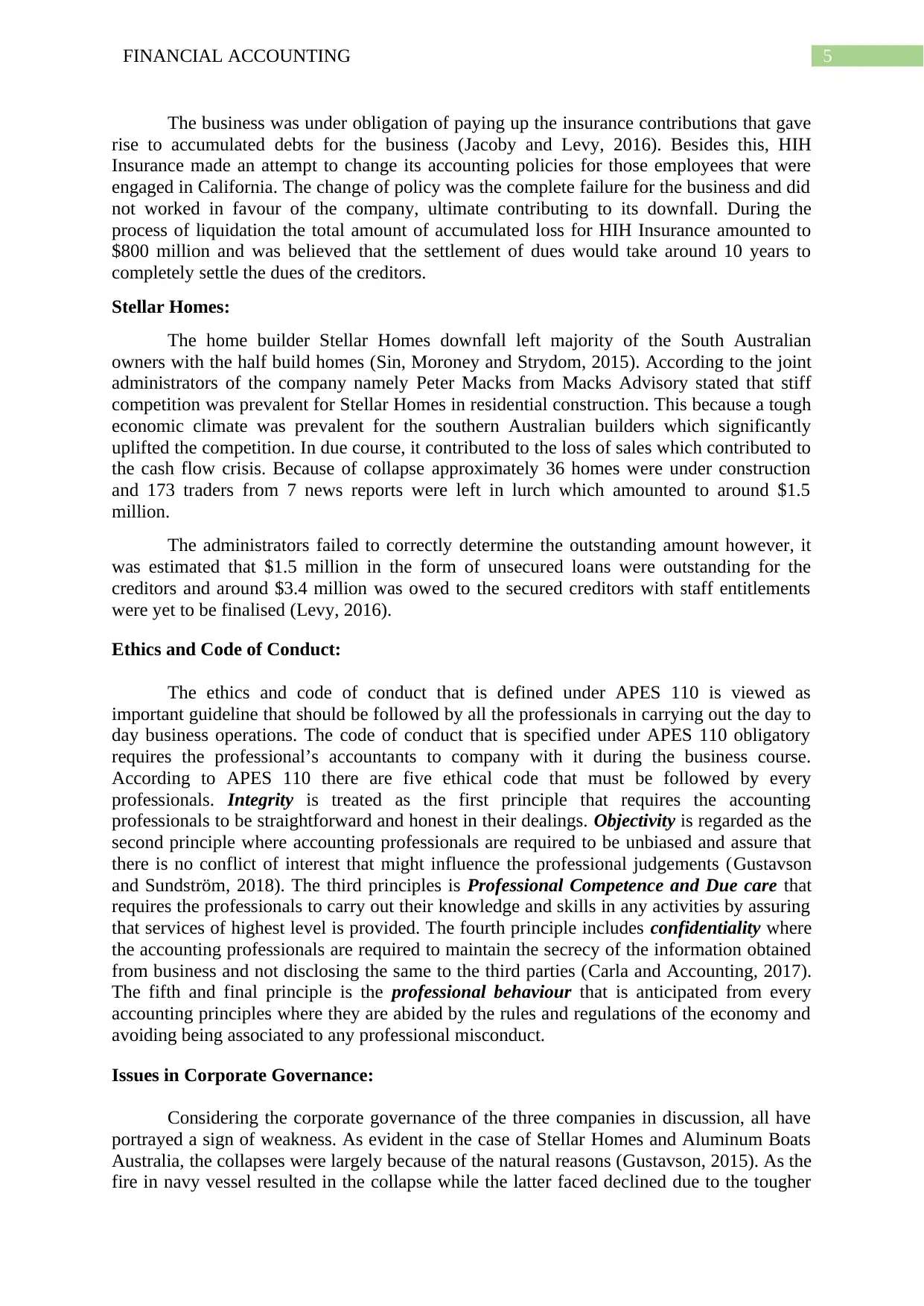
5FINANCIAL ACCOUNTING
The business was under obligation of paying up the insurance contributions that gave
rise to accumulated debts for the business (Jacoby and Levy, 2016). Besides this, HIH
Insurance made an attempt to change its accounting policies for those employees that were
engaged in California. The change of policy was the complete failure for the business and did
not worked in favour of the company, ultimate contributing to its downfall. During the
process of liquidation the total amount of accumulated loss for HIH Insurance amounted to
$800 million and was believed that the settlement of dues would take around 10 years to
completely settle the dues of the creditors.
Stellar Homes:
The home builder Stellar Homes downfall left majority of the South Australian
owners with the half build homes (Sin, Moroney and Strydom, 2015). According to the joint
administrators of the company namely Peter Macks from Macks Advisory stated that stiff
competition was prevalent for Stellar Homes in residential construction. This because a tough
economic climate was prevalent for the southern Australian builders which significantly
uplifted the competition. In due course, it contributed to the loss of sales which contributed to
the cash flow crisis. Because of collapse approximately 36 homes were under construction
and 173 traders from 7 news reports were left in lurch which amounted to around $1.5
million.
The administrators failed to correctly determine the outstanding amount however, it
was estimated that $1.5 million in the form of unsecured loans were outstanding for the
creditors and around $3.4 million was owed to the secured creditors with staff entitlements
were yet to be finalised (Levy, 2016).
Ethics and Code of Conduct:
The ethics and code of conduct that is defined under APES 110 is viewed as
important guideline that should be followed by all the professionals in carrying out the day to
day business operations. The code of conduct that is specified under APES 110 obligatory
requires the professional’s accountants to company with it during the business course.
According to APES 110 there are five ethical code that must be followed by every
professionals. Integrity is treated as the first principle that requires the accounting
professionals to be straightforward and honest in their dealings. Objectivity is regarded as the
second principle where accounting professionals are required to be unbiased and assure that
there is no conflict of interest that might influence the professional judgements (Gustavson
and Sundström, 2018). The third principles is Professional Competence and Due care that
requires the professionals to carry out their knowledge and skills in any activities by assuring
that services of highest level is provided. The fourth principle includes confidentiality where
the accounting professionals are required to maintain the secrecy of the information obtained
from business and not disclosing the same to the third parties (Carla and Accounting, 2017).
The fifth and final principle is the professional behaviour that is anticipated from every
accounting principles where they are abided by the rules and regulations of the economy and
avoiding being associated to any professional misconduct.
Issues in Corporate Governance:
Considering the corporate governance of the three companies in discussion, all have
portrayed a sign of weakness. As evident in the case of Stellar Homes and Aluminum Boats
Australia, the collapses were largely because of the natural reasons (Gustavson, 2015). As the
fire in navy vessel resulted in the collapse while the latter faced declined due to the tougher
The business was under obligation of paying up the insurance contributions that gave
rise to accumulated debts for the business (Jacoby and Levy, 2016). Besides this, HIH
Insurance made an attempt to change its accounting policies for those employees that were
engaged in California. The change of policy was the complete failure for the business and did
not worked in favour of the company, ultimate contributing to its downfall. During the
process of liquidation the total amount of accumulated loss for HIH Insurance amounted to
$800 million and was believed that the settlement of dues would take around 10 years to
completely settle the dues of the creditors.
Stellar Homes:
The home builder Stellar Homes downfall left majority of the South Australian
owners with the half build homes (Sin, Moroney and Strydom, 2015). According to the joint
administrators of the company namely Peter Macks from Macks Advisory stated that stiff
competition was prevalent for Stellar Homes in residential construction. This because a tough
economic climate was prevalent for the southern Australian builders which significantly
uplifted the competition. In due course, it contributed to the loss of sales which contributed to
the cash flow crisis. Because of collapse approximately 36 homes were under construction
and 173 traders from 7 news reports were left in lurch which amounted to around $1.5
million.
The administrators failed to correctly determine the outstanding amount however, it
was estimated that $1.5 million in the form of unsecured loans were outstanding for the
creditors and around $3.4 million was owed to the secured creditors with staff entitlements
were yet to be finalised (Levy, 2016).
Ethics and Code of Conduct:
The ethics and code of conduct that is defined under APES 110 is viewed as
important guideline that should be followed by all the professionals in carrying out the day to
day business operations. The code of conduct that is specified under APES 110 obligatory
requires the professional’s accountants to company with it during the business course.
According to APES 110 there are five ethical code that must be followed by every
professionals. Integrity is treated as the first principle that requires the accounting
professionals to be straightforward and honest in their dealings. Objectivity is regarded as the
second principle where accounting professionals are required to be unbiased and assure that
there is no conflict of interest that might influence the professional judgements (Gustavson
and Sundström, 2018). The third principles is Professional Competence and Due care that
requires the professionals to carry out their knowledge and skills in any activities by assuring
that services of highest level is provided. The fourth principle includes confidentiality where
the accounting professionals are required to maintain the secrecy of the information obtained
from business and not disclosing the same to the third parties (Carla and Accounting, 2017).
The fifth and final principle is the professional behaviour that is anticipated from every
accounting principles where they are abided by the rules and regulations of the economy and
avoiding being associated to any professional misconduct.
Issues in Corporate Governance:
Considering the corporate governance of the three companies in discussion, all have
portrayed a sign of weakness. As evident in the case of Stellar Homes and Aluminum Boats
Australia, the collapses were largely because of the natural reasons (Gustavson, 2015). As the
fire in navy vessel resulted in the collapse while the latter faced declined due to the tougher
⊘ This is a preview!⊘
Do you want full access?
Subscribe today to unlock all pages.

Trusted by 1+ million students worldwide
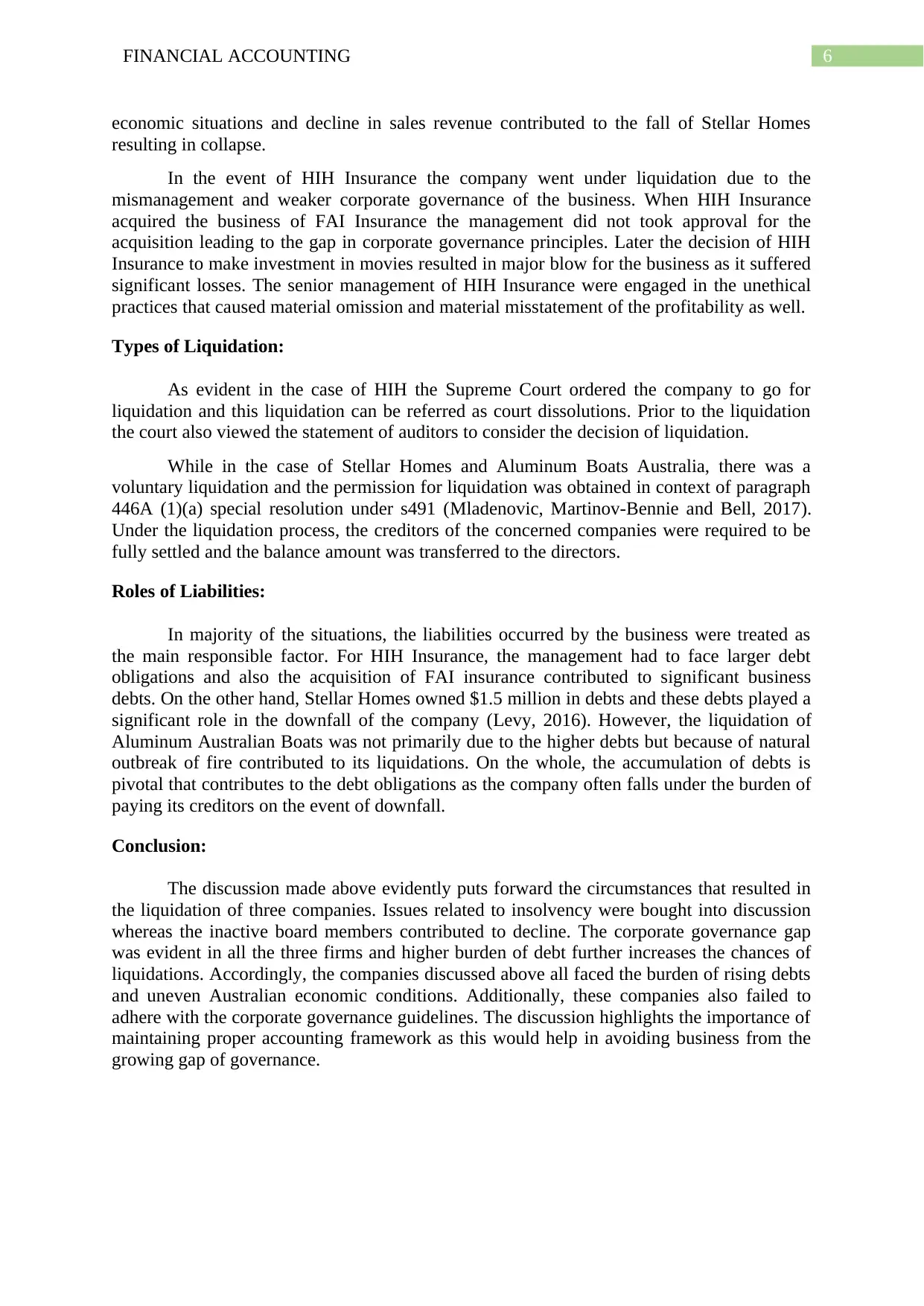
6FINANCIAL ACCOUNTING
economic situations and decline in sales revenue contributed to the fall of Stellar Homes
resulting in collapse.
In the event of HIH Insurance the company went under liquidation due to the
mismanagement and weaker corporate governance of the business. When HIH Insurance
acquired the business of FAI Insurance the management did not took approval for the
acquisition leading to the gap in corporate governance principles. Later the decision of HIH
Insurance to make investment in movies resulted in major blow for the business as it suffered
significant losses. The senior management of HIH Insurance were engaged in the unethical
practices that caused material omission and material misstatement of the profitability as well.
Types of Liquidation:
As evident in the case of HIH the Supreme Court ordered the company to go for
liquidation and this liquidation can be referred as court dissolutions. Prior to the liquidation
the court also viewed the statement of auditors to consider the decision of liquidation.
While in the case of Stellar Homes and Aluminum Boats Australia, there was a
voluntary liquidation and the permission for liquidation was obtained in context of paragraph
446A (1)(a) special resolution under s491 (Mladenovic, Martinov-Bennie and Bell, 2017).
Under the liquidation process, the creditors of the concerned companies were required to be
fully settled and the balance amount was transferred to the directors.
Roles of Liabilities:
In majority of the situations, the liabilities occurred by the business were treated as
the main responsible factor. For HIH Insurance, the management had to face larger debt
obligations and also the acquisition of FAI insurance contributed to significant business
debts. On the other hand, Stellar Homes owned $1.5 million in debts and these debts played a
significant role in the downfall of the company (Levy, 2016). However, the liquidation of
Aluminum Australian Boats was not primarily due to the higher debts but because of natural
outbreak of fire contributed to its liquidations. On the whole, the accumulation of debts is
pivotal that contributes to the debt obligations as the company often falls under the burden of
paying its creditors on the event of downfall.
Conclusion:
The discussion made above evidently puts forward the circumstances that resulted in
the liquidation of three companies. Issues related to insolvency were bought into discussion
whereas the inactive board members contributed to decline. The corporate governance gap
was evident in all the three firms and higher burden of debt further increases the chances of
liquidations. Accordingly, the companies discussed above all faced the burden of rising debts
and uneven Australian economic conditions. Additionally, these companies also failed to
adhere with the corporate governance guidelines. The discussion highlights the importance of
maintaining proper accounting framework as this would help in avoiding business from the
growing gap of governance.
economic situations and decline in sales revenue contributed to the fall of Stellar Homes
resulting in collapse.
In the event of HIH Insurance the company went under liquidation due to the
mismanagement and weaker corporate governance of the business. When HIH Insurance
acquired the business of FAI Insurance the management did not took approval for the
acquisition leading to the gap in corporate governance principles. Later the decision of HIH
Insurance to make investment in movies resulted in major blow for the business as it suffered
significant losses. The senior management of HIH Insurance were engaged in the unethical
practices that caused material omission and material misstatement of the profitability as well.
Types of Liquidation:
As evident in the case of HIH the Supreme Court ordered the company to go for
liquidation and this liquidation can be referred as court dissolutions. Prior to the liquidation
the court also viewed the statement of auditors to consider the decision of liquidation.
While in the case of Stellar Homes and Aluminum Boats Australia, there was a
voluntary liquidation and the permission for liquidation was obtained in context of paragraph
446A (1)(a) special resolution under s491 (Mladenovic, Martinov-Bennie and Bell, 2017).
Under the liquidation process, the creditors of the concerned companies were required to be
fully settled and the balance amount was transferred to the directors.
Roles of Liabilities:
In majority of the situations, the liabilities occurred by the business were treated as
the main responsible factor. For HIH Insurance, the management had to face larger debt
obligations and also the acquisition of FAI insurance contributed to significant business
debts. On the other hand, Stellar Homes owned $1.5 million in debts and these debts played a
significant role in the downfall of the company (Levy, 2016). However, the liquidation of
Aluminum Australian Boats was not primarily due to the higher debts but because of natural
outbreak of fire contributed to its liquidations. On the whole, the accumulation of debts is
pivotal that contributes to the debt obligations as the company often falls under the burden of
paying its creditors on the event of downfall.
Conclusion:
The discussion made above evidently puts forward the circumstances that resulted in
the liquidation of three companies. Issues related to insolvency were bought into discussion
whereas the inactive board members contributed to decline. The corporate governance gap
was evident in all the three firms and higher burden of debt further increases the chances of
liquidations. Accordingly, the companies discussed above all faced the burden of rising debts
and uneven Australian economic conditions. Additionally, these companies also failed to
adhere with the corporate governance guidelines. The discussion highlights the importance of
maintaining proper accounting framework as this would help in avoiding business from the
growing gap of governance.
Paraphrase This Document
Need a fresh take? Get an instant paraphrase of this document with our AI Paraphraser
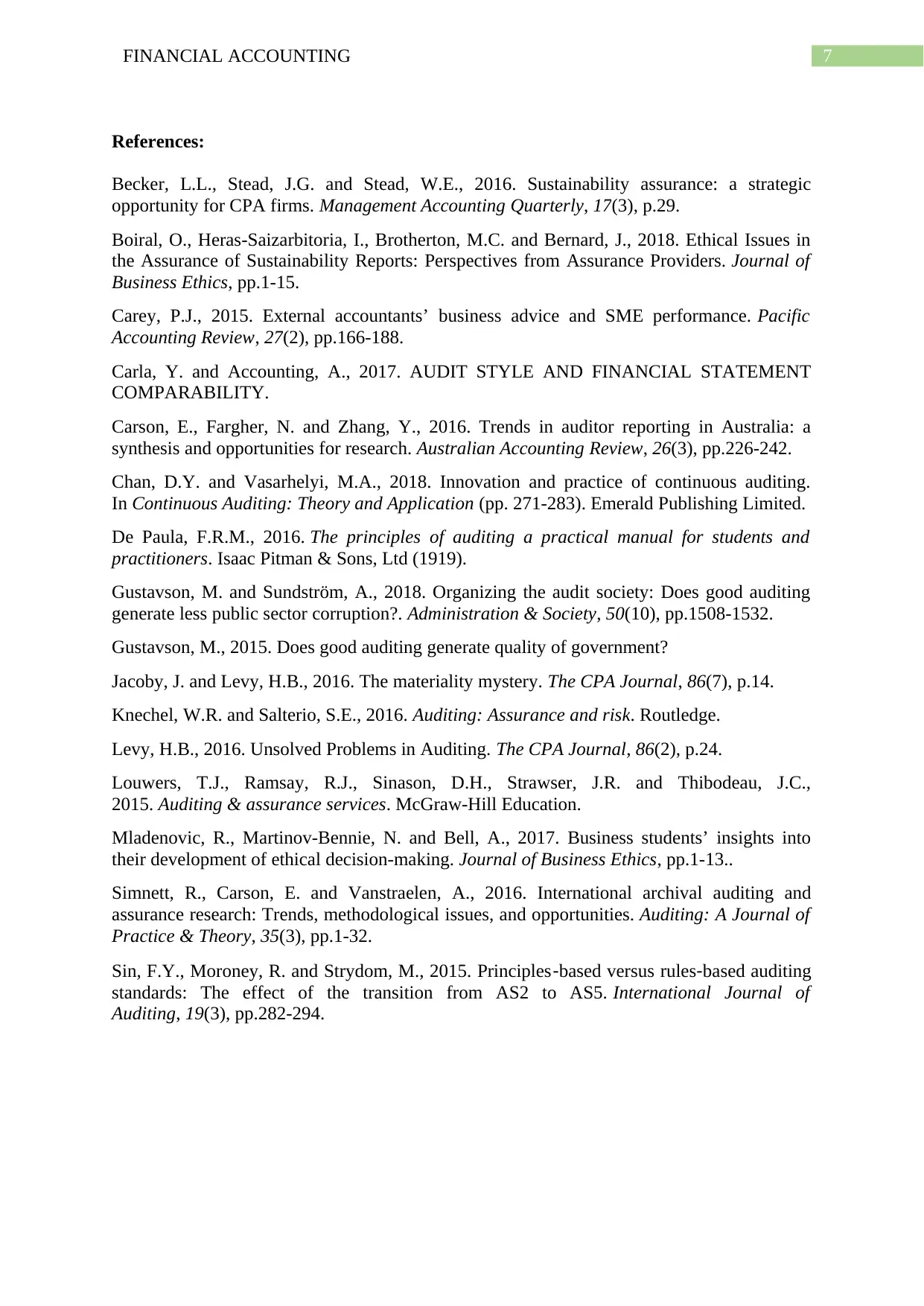
7FINANCIAL ACCOUNTING
References:
Becker, L.L., Stead, J.G. and Stead, W.E., 2016. Sustainability assurance: a strategic
opportunity for CPA firms. Management Accounting Quarterly, 17(3), p.29.
Boiral, O., Heras-Saizarbitoria, I., Brotherton, M.C. and Bernard, J., 2018. Ethical Issues in
the Assurance of Sustainability Reports: Perspectives from Assurance Providers. Journal of
Business Ethics, pp.1-15.
Carey, P.J., 2015. External accountants’ business advice and SME performance. Pacific
Accounting Review, 27(2), pp.166-188.
Carla, Y. and Accounting, A., 2017. AUDIT STYLE AND FINANCIAL STATEMENT
COMPARABILITY.
Carson, E., Fargher, N. and Zhang, Y., 2016. Trends in auditor reporting in Australia: a
synthesis and opportunities for research. Australian Accounting Review, 26(3), pp.226-242.
Chan, D.Y. and Vasarhelyi, M.A., 2018. Innovation and practice of continuous auditing.
In Continuous Auditing: Theory and Application (pp. 271-283). Emerald Publishing Limited.
De Paula, F.R.M., 2016. The principles of auditing a practical manual for students and
practitioners. Isaac Pitman & Sons, Ltd (1919).
Gustavson, M. and Sundström, A., 2018. Organizing the audit society: Does good auditing
generate less public sector corruption?. Administration & Society, 50(10), pp.1508-1532.
Gustavson, M., 2015. Does good auditing generate quality of government?
Jacoby, J. and Levy, H.B., 2016. The materiality mystery. The CPA Journal, 86(7), p.14.
Knechel, W.R. and Salterio, S.E., 2016. Auditing: Assurance and risk. Routledge.
Levy, H.B., 2016. Unsolved Problems in Auditing. The CPA Journal, 86(2), p.24.
Louwers, T.J., Ramsay, R.J., Sinason, D.H., Strawser, J.R. and Thibodeau, J.C.,
2015. Auditing & assurance services. McGraw-Hill Education.
Mladenovic, R., Martinov-Bennie, N. and Bell, A., 2017. Business students’ insights into
their development of ethical decision-making. Journal of Business Ethics, pp.1-13..
Simnett, R., Carson, E. and Vanstraelen, A., 2016. International archival auditing and
assurance research: Trends, methodological issues, and opportunities. Auditing: A Journal of
Practice & Theory, 35(3), pp.1-32.
Sin, F.Y., Moroney, R. and Strydom, M., 2015. Principles‐based versus rules‐based auditing
standards: The effect of the transition from AS2 to AS5. International Journal of
Auditing, 19(3), pp.282-294.
References:
Becker, L.L., Stead, J.G. and Stead, W.E., 2016. Sustainability assurance: a strategic
opportunity for CPA firms. Management Accounting Quarterly, 17(3), p.29.
Boiral, O., Heras-Saizarbitoria, I., Brotherton, M.C. and Bernard, J., 2018. Ethical Issues in
the Assurance of Sustainability Reports: Perspectives from Assurance Providers. Journal of
Business Ethics, pp.1-15.
Carey, P.J., 2015. External accountants’ business advice and SME performance. Pacific
Accounting Review, 27(2), pp.166-188.
Carla, Y. and Accounting, A., 2017. AUDIT STYLE AND FINANCIAL STATEMENT
COMPARABILITY.
Carson, E., Fargher, N. and Zhang, Y., 2016. Trends in auditor reporting in Australia: a
synthesis and opportunities for research. Australian Accounting Review, 26(3), pp.226-242.
Chan, D.Y. and Vasarhelyi, M.A., 2018. Innovation and practice of continuous auditing.
In Continuous Auditing: Theory and Application (pp. 271-283). Emerald Publishing Limited.
De Paula, F.R.M., 2016. The principles of auditing a practical manual for students and
practitioners. Isaac Pitman & Sons, Ltd (1919).
Gustavson, M. and Sundström, A., 2018. Organizing the audit society: Does good auditing
generate less public sector corruption?. Administration & Society, 50(10), pp.1508-1532.
Gustavson, M., 2015. Does good auditing generate quality of government?
Jacoby, J. and Levy, H.B., 2016. The materiality mystery. The CPA Journal, 86(7), p.14.
Knechel, W.R. and Salterio, S.E., 2016. Auditing: Assurance and risk. Routledge.
Levy, H.B., 2016. Unsolved Problems in Auditing. The CPA Journal, 86(2), p.24.
Louwers, T.J., Ramsay, R.J., Sinason, D.H., Strawser, J.R. and Thibodeau, J.C.,
2015. Auditing & assurance services. McGraw-Hill Education.
Mladenovic, R., Martinov-Bennie, N. and Bell, A., 2017. Business students’ insights into
their development of ethical decision-making. Journal of Business Ethics, pp.1-13..
Simnett, R., Carson, E. and Vanstraelen, A., 2016. International archival auditing and
assurance research: Trends, methodological issues, and opportunities. Auditing: A Journal of
Practice & Theory, 35(3), pp.1-32.
Sin, F.Y., Moroney, R. and Strydom, M., 2015. Principles‐based versus rules‐based auditing
standards: The effect of the transition from AS2 to AS5. International Journal of
Auditing, 19(3), pp.282-294.
1 out of 8
Related Documents
Your All-in-One AI-Powered Toolkit for Academic Success.
+13062052269
info@desklib.com
Available 24*7 on WhatsApp / Email
![[object Object]](/_next/static/media/star-bottom.7253800d.svg)
Unlock your academic potential
Copyright © 2020–2025 A2Z Services. All Rights Reserved. Developed and managed by ZUCOL.




